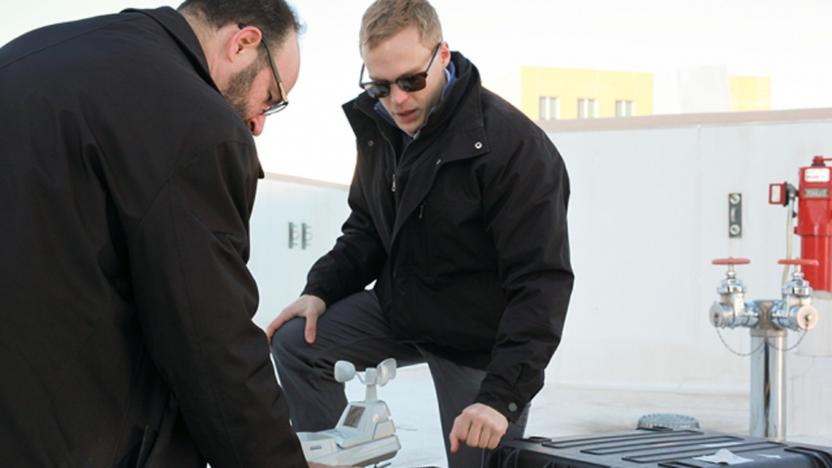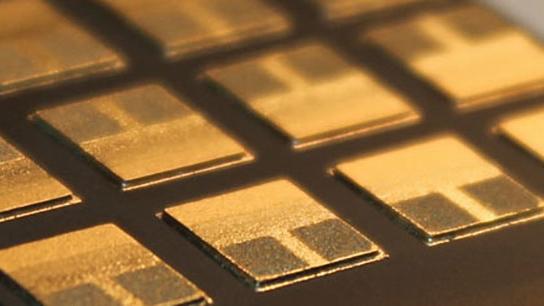thermoelectric
Latest

Device provides years of power through temperature swings
Eventually, you might not need a battery or a conspicuous external power source to keep a device running for years on end. A team at MIT has created a device that produces energy by exploiting the temperature swings that occur between day and night. Known as a thermal resonator, it uses a hybrid of materials that produce both high heat conduction and capacity. A copper or nickel foam at its core is coated with graphene to boost its conductivity, and is infused with a phase-changing material (octadecane) that serves as storage. Effectively, one side of the device is always capturing heat while the other is storing it -- you just have to harvest that energy with conventional techniques.

Researchers find a new way to convert heat into electricity
When we think about ways to make existing power plants more efficient, we typically look at waste heat. It's something almost everything generates -- coal plants, automobiles and even your refrigerator loses a sizeable amount of energy to lost heat. Capturing and using this heat to generate electricity with can save money and reduce fossil fuel consumption, but capturing power from that heat has always been a challenge. Now, researchers have created a new material that could represent a major step forward in thermoelectric electricity production.

Generating power from heat will soon be dirt cheap
You could power your car's cooling AC using wasted heat, ironically, without a solar panel in sight.

Researchers find graphene transistors cool themselves, silicon counterparts seethe with envy
We've seen graphene promise some pretty slick tricks already: budget-minded bendable batteries, superior stain resistance, and upping ultracapacitors' energy density. We can now add self-cooling transistors to the list of awesome, yet unfulfilled possibilities for these microscopic sheets of carbon. Using an atomic force microscope, a team of researchers at the University of Illinois led by Professor William King discovered that graphene transistors have a thermoelectric cooling effect where they make their metal connections. This self-cooling is greater than the resistive heating that normally follows the flow of electrons -- meaning graphene-based electronics from the future could make their silicon competition look decidedly uncool in comparison.

Energy-efficient military uniforms to make solar-powered necktie so last season
This definitely isn't the first time we've heard of wearable solar cells, but a new development underway in the UK could certainly have a greater impact than, say, an iPod-charging denim jacket. By combining photovoltaic cells with thermoelectric devices, a team of researchers is working to create new, more efficient uniforms for British troops. The solar-powered outfits could cut the weight of traditional battery packs in half, allow for significantly longer military missions, and actually absorb energy across the electromagnetic spectrum, decreasing the possibility of detection by infrared technology. To ensure 24-hour power, the solar cells will collect energy in daylight, with thermoelectric devices taking on the task at night. A prototype is set for 2013, but we wonder how long it will take to hit the catwalk.

Inhabitat's Week in Green: solar buildings, solar stadiums, and an algae-powered lamp
The Week in Green is a new item from our friends at Inhabitat, recapping the week's most interesting green developments and clean tech news for us. The past week Inhabitat saw solar-powered transportation soar into space as Japan successfully unfurled the world's first solar sail aboard its Ikaros spacecraft. We continued our transportation coverage by taking a took a look at a futuristic plant-powered photosynthetic concept car that seats riders within an enclosed jungle canopy. However if the Inhabitat editors commuted to work, it would probably be via these amazing solar-powered shrub cars! In other news, the world of architecture is heating up with the onset of summer as countries around the globe gear up to unveil high-tech sun-powered homes at the European Solar Decathlon. This week we took a look at two of our favorites - the solar shelled Armadillo Box House and Finland's hyper-insulated Luuku House, which is expected to generate more energy than it consumes. We also celebrated the launch of the 2010 World Cup by taking a look at the technologies behind five stunning green stadiums that will be hosting this year's games in South Africa. Speaking of the World Cup, this week were also excited to see the unveiling of a brand new version of the sOccket, an energy-generating soccer ball that scores a goal for green power in developing countries. We also took a look at a cheap solar-powered refrigerator for the developing world that can be assembled using local materials and could save millions of lives by storing and distributing vaccines. Renewable energy was also a hot topic this week -- the UAE is blazing a trail with plans to construct a record-toppling solar plant that eclipses the size of every photovoltaic farm to date. We also saw home-grown algae power make its domestic debut in this gorgeous green Latro Lamp, which is fueled by a pond-scum powered bio-battery. And renewable energy took to the streets this week as telecom provider Orange unveiled a set of spiffy set of thermoelectric galoshes that charge your cellphone using heat from your feet. Finally, this week we unveiled some incredible new uses for everyday materials as we announced the grand-prize winners of our 2010 Spring Greening DIY Design Competition. Speaking of innovative examples of repurposed design, we were also blown away by this open-source printer made from LEGO bricks and a felt-tip pen. And if you insist on continuing to use a standard printer, you can rest assured that there's an inspired re-use for those expired ink cartridges - Australia recently unveiled a bike path made from them!

Apple patent filings detail methods of keeping your devices cool
Apple is a pretty innovative company, and here at TUAW we receive a lot of tips about new patents that have been filed by the company. While not all of the patents make it into products, Apple is assiduous about filing for patent protection on their intellectual property. This week featured 4 patent applications from Apple that are all about keeping your devices cool. The first, titled "Methods and Apparatus for Cooling Electronic Devices Using Flow Sensors," talks about using tiny sensors to determine the air velocity in a device and then adjusting fan speeds and/or computing power to keep the device cool. The second application seems so obvious it's surprising nobody has filed it before. Titled "Methods and Apparatus for Cooling Electronic Devices Through User Interfaces," the patent filing describes how to use input/output ports (FireWire, USB, and Ethernet) to increase airflow through a device. In particular, the application details how ports can be positioned to provide the best possible cooling of components. The third patent filing, "Methods and Apparatus for Cooling Electronic Devices Using Conductive Hinge Assemblies," is specifically focused on notebook type devices. Here, the hinges on a notebook's screen are effectively used as heat exchangers to cool certain heat-producing components. The last filing, "Methods and Apparatus for Cooling Electronic Devices using Thermoelectric Cooling Components," describes using the Peltier Effect to actively cool components. This can be also described as "solid-state cooling." While it's uncertain when or if we'll see any of these patents come to life in a future Apple product, it is great to see that they're trying to figure out a way to keep MacBooks from being used as frying pans. [via AppleInsider]

Corsair's Peltier memory cooler gets demonstrated
Corsair's Dominator memory can apparently get quite hot, particularly if the overclocking bug catches you right. If a product shown off at CES hits the commercial market, however, everything is sure to stay cool. The Peltier cooling device is expected to play nice with second-gen Dominator modules, and when attached to existing heatsinks it can be used to cool a larger heat block in pretty much any water cooling setup. We know, you're probably scratching your head, but hop on past the break for a quick video demonstration.[Thanks, Ryan]

Waste heat close to becoming useful in cooling / lighting applications
Not that waste heat in general hasn't been repurposed for non-wasteful activities before, but researchers at Doshisha University are now edging ever closer to making useful the previously annoying thermoacoustic phenomenon. For those not really tied into the science realm, said phenomenon is a nonlinear one in which "heated air autonomously transforms into sound when passing through small mesh holes in a wire sheet." Gurus are now developing a cooling technology that would have heat converted to sound, where it would then be transferred through a tube and reconverted into heat; furthermore, other whiz-kids are looking to generate actual electricity from the racket. In related news, the thermoelectric conversion is being used to transform waste heat from candles into energy for LEDs, which would emit more light than the candle powering it. Pop on past the break for a demonstration of the former.

Another team figures out how to convert waste heat into energy
Not that mad scientists haven't figured out a way to convert waste heat into energy, but a team from Ohio State University has developed a new material that does the same sort of thing... just way, way better. The new material goes by the name thallium-doped lead telluride, and at least in theory, it could actually convert exhaust heat from vehicles into electricity. According to a new report about to hit the journal Science, the material packs "twice the efficiency of anything currently on the market," though it still seems as if it's a good ways out from being ready for commercial applications. Nanotechnology geeks -- you've got a real treat waiting in the read link.[Via CNET]

Researchers hope to charge up gadgetry with body heat
We've heard of firms tinkering with the idea of converting excess heat directly to energy, and apparently, a team of scientists from the US Department of Energy's Lawrence Berkeley National Laboratory and the University of California at Berkeley have done just that. Oddly enough, the researchers admit that they're still unclear on how their findings actually work, but they've nevertheless discovered how to increase the conversion efficiency of converting waste heat to energy "by a factor of 100." The authors of the report suggest that clothing constructed of material embedded with thermoelectric modules could one day "recharge mobile electronic devices off the heat of one's body," and while we're certainly stoked about the idea, we're already conjuring up awful images in our minds about what this garb will actually look like.[Via textually, image courtesy of FourEyesJokeShop]

Nextreme crafts thermoelectric module for microscopic cooling
It's been a tick since anyone 'round these parts has taken Peltier cooling seriously, but sure enough, North Carolina-based Nextreme Thermal Solutions is giving us reason to spark that conversation up once more. Its Ultra-High Packing Fraction (UPF) OptoCooler module utilizes "thin-film thermal bump technology at its core," essentially enabling it to be "integrated directly into electronic and optoelectronic packaging to deliver more than 45°C of cooling." Initially, the outfit hopes to have its product embedded within LED packages to "control temperatures and maintain proper operating conditions," and while we'd certainly be more awestruck if these were headed straight for microprocessors of some sort, we've all ideas Nextreme's already working on that endeavor.[Via Slashdot]

Body powered circuits developed by Fraunhofer Institute
Our favorite German researchers over at the Fraunhofer Institute have developed "entire electronic systems" capable of operating battery-free from body heat alone. The picture above shows a wireless transmitter powered by the human hand. The 200 millivolts required to drive the device is supplied by a thermoelectric generator (TEG) which extracts electrical energy from hot and a cold temperature differentials of just a few degrees Celsius. Of course, the application processor alone in modern handhelds requires about 1W to operate so 2mW is a long way off from powering our portable electronics. Still, progress is progress.






